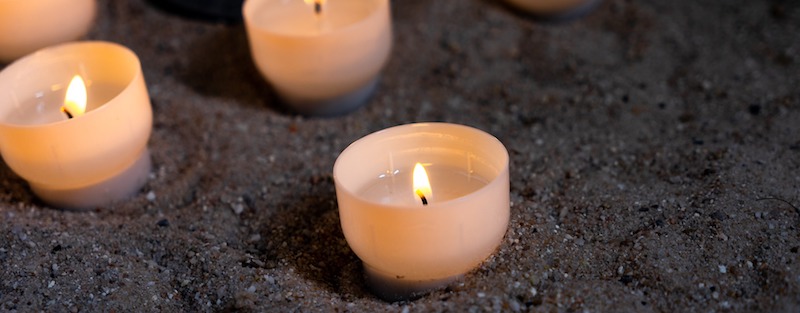Many people have told me that they’ve tried mindfulness meditation — even meditation for beginners — but “just couldn’t do it.” Some of this stems from common misconceptions about meditation, such as there’s only one way to meditate or you shouldn’t have any thoughts during meditation.
Beginners often think that they can’t meditate because they have too many thoughts. The truth is, one of the reasons we meditate is because we have “too many thoughts,” or more specifically, our thoughts race all over. However, the goal of meditation is not to eliminate these thoughts, but to let them flow past without capturing our attention.
There are also many types of meditation, from sitting or walking, to ones focused on the breath or an object like a candle, and even meditations that involve visualizing an object or a feeling. The best meditation is the one that works, because when it’s a good fit, you will have an easier time practicing every day.
One of the meditations that I often do in my own practice is a sitting mindfulness meditation that involves focusing on the breath. This is similar to one that I learned when I first started meditating. Because it is so simple, it is an excellent meditation for beginners to try.
Preparing for Mindfulness Meditation for Beginners
Where to sit. If you don’t happen to have a room in your house or apartment dedicated to meditating, don’t worry. You can meditate anywhere. That’s the beauty of meditation. However, it’s nice to find a space where you can sit undisturbed for a few minutes, whether that’s in your living room or in a closet. If you are doing this meditation with your eyes open, position yourself so you aren’t looking at things that will remind you of your work or household chores.
When to meditate. The best time to meditate is when you will actually do it. So find a time that works for you. If you are an early riser like me, meditating shortly after waking can be a nice way to start the day. But you may find that you are more alert later in the day, or that you are more focused shortly before bed. I often meditate after my yoga practice (and sometimes after my workouts), because my body is in a calmer state.
How long to meditate. Some people who teach meditation for beginners recommend that students start with 20 to 30 minutes a day. If you can do this consistently — which means on most days — then go for it. The more you meditate, the greater the benefits. But every little bit of meditation counts. So if five minutes is all you can do every day, then start there. You can increase this over time. Another option is to do five to 10 minutes of meditation a day, with a longer meditation one day a week (or month).
How to sit. Some meditation traditions have strict rules about the seated posture. While this is great for seasoned meditators, I think beginners learning to meditate should sit in a position that they can comfortably maintain.
In general, your torso should be upright — no slouching or hunched shoulders. Also, staying in that position shouldn’t create pain. If your hips or lower back are tight, you might find that sitting on a chair is easier than sitting on the floor. If you are on the floor, you can also sit on a firm pillow or a bolster.
As you sit, keep your chin slightly tucked. This helps lengthen the back of the neck. Imagine the top of your head reaching up toward the sky, with an imaginary line running from the base of your spine through your torso and out the top of your head.
You can have your eyes closed or slightly open. Gaze softly at the floor about eighteen inches in front of you (if your eyes are closed, you can still gaze in that direction). If I am sleepy, I sometimes gaze a little higher, such as toward the wall rather than the floor; this helps me stay alert while meditating.
Rest your hands on your knees with the palms down. Or you can stack your hands in your lap, with your nondominant hand on top,the palms facing up and the thumbs touching.
You’re now ready to start meditating.

Sitting Meditation for Beginners
Here are the steps to this mindfulness meditation for beginners:
- Bring your attention to your breath. Rather than trying to control the breath, simply watch it. Notice as it shifts, sometimes short or shallow, sometimes long or deep. You can play with keeping your attention on the nostrils, or on your abdomen about two fingers below the navel.
- In some traditions, meditators mentally count the breaths as they occur — breathe in, “one”; breathe out, “two”; breathe in, “three.” The goal of counting isn’t to reach a certain number, but to help you keep your attention on your breath.
- Continue like this for the rest of your meditation.
You might be wondering, “Is meditation really that simple?” The answer is yes … and no.
The entire goal of meditation is to bring your awareness to one specific object — in this case the breath — and keep it there. So every time your awareness is on your breath, you are being mindful.
However, there are many times when your attention shifts elsewhere, often without you realizing it. Usually what happens is that at some point you notice that you’re thinking about something other than your breath — what you ate for lunch, a movie you saw, how great you are at meditating.
Maybe only a few seconds have elapsed since your attention was last on your breath. But sometimes you are lost in your thoughts for minutes at a time.
Whenever you realize that you are no longer focused on your breath, let go of whatever you were thinking about and bring your attention back to your breath.
This is the heart of meditation — noticing that your mind has drifted off and bringing your attention back.
With practice, you will spend less time lost in your thoughts. You also start to catch yourself drifting off sooner. Over time, your mindfulness will grow stronger and it becomes easier to keep your attention on the present moment, even outside of your meditation practice.
_____
“Feelings come and go like clouds in a windy sky. Conscious breathing is my anchor.”
― TStepping into Freedom: Rules of Monastic Practice for Novices



Great post! I love how simple and approachable you’ve made meditation for beginners. I’ve found starting with a minute of mindful breathing really helps me focus. I recently shared a tip on staying consistent with meditation—would love your thoughts on it. Thanks for the inspiration!